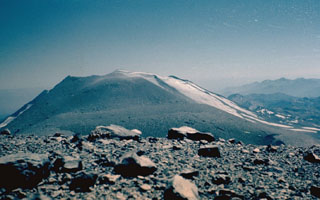Report on Nevados de Chillan (Chile) — 16 March-22 March 2022
Smithsonian Institution / US Geological Survey
Weekly Volcanic Activity Report, 16 March-22 March 2022
Managing Editor: Sally Sennert.
Please cite this report as:
Global Volcanism Program, 2022. Report on Nevados de Chillan (Chile) (Sennert, S, ed.). Weekly Volcanic Activity Report, 16 March-22 March 2022. Smithsonian Institution and US Geological Survey.
Nevados de Chillan
Chile
36.868°S, 71.378°W; summit elev. 3180 m
All times are local (unless otherwise noted)
SERNAGEOMIN reported that lava in Nevados de Chillán’s Nicanor Crater was observed in satellite images on 1 March and coincided with elevated thermal temperatures also identified in satellite images. A higher resolution satellite image acquired on 15 March showed the extrusive lava feature in more detail; it was about 33 x 57 m elongated E-W, and had irregular edges. The emplacement of the lava was contemporaneous with nighttime crater incandescence and moderate explosive activity. Steam plumes with occasional tephra content rose to heights less than 1.5 km above the crater rim. Seismic activity had steadily declined since January. During the first half of March sulfur dioxide emissions averaged 454 tons per day, peaking at an anomalously high value of 2,348 tons per day on 13 March. The Alert Level remained at Yellow, the second lowest level on a four-color scale. ONEMI stated that Alert Level Yellow (the middle level on a three-color scale) remained in place for the communities of Pinto and Coihueco, noting that the public should stay at least 2 km away from the crater.
Geological Summary. The compound volcano of Nevados de Chillán is one of the most active of the Central Andes. Three late-Pleistocene to Holocene stratovolcanoes were constructed along a NNW-SSE line within three nested Pleistocene calderas, which produced ignimbrite sheets extending more than 100 km into the Central Depression of Chile. The dominantly andesitic Cerro Blanco (Volcán Nevado) stratovolcano is located at the NW end of the massif. Volcán Viejo (Volcán Chillán), which was the main active vent during the 17th-19th centuries, occupies the SE end. The Volcán Nuevo lava-dome complex formed during 1906-1945 on the NW flank of Viejo. The Volcán Arrau dome complex was then constructed on the SE side of Volcán Nuevo between 1973 and 1986, and eventually exceeded its height. Smaller domes or cones are present in the 5-km valley between the two major edifices.
Sources: Servicio Nacional de Geología y Minería (SERNAGEOMIN), Oficina Nacional de Emergencia-Ministerio del Interior (ONEMI)

